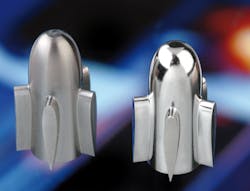Laser polishing speeds surface finish of dental and blood-carrying implants
The MediSurf project, funded by the German Federal Ministry of Economics and Technology (Berlin, Germany) and led by the Fraunhofer Institute for Laser Technology (ILT; Aachen, Germany), has found that laser polishing to automatically polish dental and blood-carrying implants has many benefits, including higher reproducibility and lower cost.
Surface quality of an implant plays a significant role for use in the body. For example, bone implants require a porous structure so that cells can grow into them well. Other implants, however, need as smooth a surface as possible to keep bacteria from attaching and from damaging the surrounding tissue.
First, the project partners looked to optimize the surface of the titanium ventricular assist system INCOR, which is produced by Berlin Heart. The project aimed at reducing production time and guaranteeing high hemocompatibility (leaving blood corpuscles undamaged and, in turn, significantly reducing risk of heart attacks and strokes).
Initially, the partners sought to resolve whether or not laser-based polishing of the surface can achieve the same hemocompatibility as with manual polishing. To answer this, researchers at Fraunhofer ILT developed a process to polish blood-carrying implants with lasers. “We are able to reduce the micro-roughness to such an extent that the implant exhibits the best possible hemocompatibility. However, we began with very little information on exactly what quality the surface had to have for this purpose,” explains project leader Christian Nüsser. “For this reason, we had to test various parameters to reach the desired result.”
The implants were tested for their hemocompatibility by the University Hospital Münster (UKM; Münster, Germany). Findings confirmed that laser-polished implants exhibit the same hemocompatibility as those polished manually, but laser polishing is 30 to 40 times faster. What's more, it reduces production costs, exhibits higher reproducibility, and guarantees a homogeneous smoothness over the entire surface of a free-form geometrical component, even on corners and edges, which are difficult to reach when polished manually.
A prototype plant has been developed at Fraunhofer ILT for automated laser polishing of implants. The scientists have also developed a glove box with a six-axis articulated robot, which can grasp the implants and process a complete series of them on its own. This automated machine engineering makes the entire process less expensive, more flexible, and appropriate for industrial series production.
-----
Subscribe now to Laser Focus World magazine; it's free!
